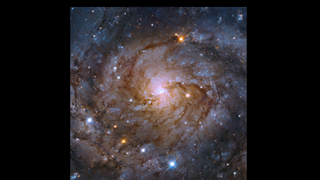
Watch the “hidden galaxy” as it unfolds.
This is glorious Hubble Space Telescope The image shows the spiral galaxy IC 342, also known as Caldwell 5. No matter what you call it galaxyScientists have found it somewhat difficult to notice due to obstacles in its path, which has earned it its nickname of “hidden,” according to NASA.
It appears near the equator Milky WayThe pearly disk, filled with thick cosmic gases, dark dust, and glowing stars that all obscure our view,” NASA wrote on May 11. statement (Opens in a new tab).
Related: The best Hubble Space Telescope pictures of all time!

The Hubble telescope can look through the debris, to an extent, because the telescope has infrared capabilities. Infrared light is less scattered by dust and allows a clearer view of the galaxy beyond the interstellar matter.
This shimmering view of a face at the center of the galaxy displays tangled tendrils of dust with stunning arms that wrap around a shining core of hot gas and starsShe wrote, “NASA about the photo.
“This core is a specific type of region called a H II core – a region of atomic hydrogen that has become ionized. These regions are active star birth places where thousands of stars can form over two million years.”
NASA said that blue stars ionize or activate hydrogen surrounding their birthplace due to the emission of ultraviolet radiation. The galaxy would be one of the brightest in our sky if there wasn’t a lot of dust in the way.
IC 342 is also relatively close in galactic , only 11 million light years from Earth. It’s about half the radius of our Milky Way galaxy (it’s 50,000 light-years in diameter), which also makes it relatively large.
Hubble has been in space for a generation and has photographed this galaxy many times before. You can also discover its imaging of IC 342 in 2017 (Opens in a new tab) And the 2010 (Opens in a new tab).
Follow Elizabeth Howell on Twitter Tweet embed (Opens in a new tab). Follow us on Twitter Tweet embed (Opens in a new tab) or Facebook.

“Explorer. Unapologetic entrepreneur. Alcohol fanatic. Certified writer. Wannabe tv evangelist. Twitter fanatic. Student. Web scholar. Travel buff.”



